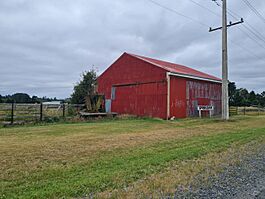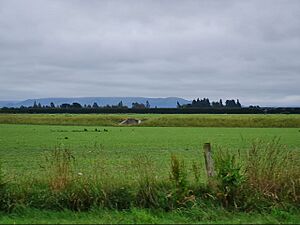Oxford Branch (New Zealand) facts for kids
Quick facts for kids Oxford Branch |
|
|---|---|

Springbank engine shed and its station sign, December 2023
|
|
| Overview | |
| Status | Closed |
| Owner | Railways Department |
| Locale | Canterbury, New Zealand |
| Termini | Rangiora Sheffield |
| Stations | 13 |
| Service | |
| Type | Heavy Rail |
| System | New Zealand Government Railways (NZGR) |
| Operator(s) | Railways Department |
| History | |
| Opened | 28 July 1884 |
| Closed | 14 July 1930 (Sheffield – Oxford East) 19 April 1959 (Oxford East – Rangiora) |
| Technical | |
| Line length | 35.47 km (Rangiora – Oxford West) |
| Number of tracks | Single |
| Character | Rural |
| Track gauge | 3 ft 6 in (1,067 mm) |
The Oxford Branch was a special railway line in New Zealand. It was like a smaller road that connected to the main railway network. This line was in the Canterbury area of the South Island. It ran somewhat next to another line called the Eyreton Branch, about ten kilometres away.
The Oxford Branch opened to the town of Oxford in 1875. It kept running until 1959. What was special about it was that for most of its life, it linked two main railway lines. These were the Main North Line and the Midland Line. It was the only part of a bigger railway plan, called the Canterbury Interior Main Line, that ever got built.
Building the Railway Line
In the late 1860s, the Oxford area had very poor ways to transport goods. But it had one of Canterbury's two biggest forests. Because of this, people thought it was very important to build a railway line. This line would help move timber (wood) from the forest.
The main railway line, the Main North Line, was being built up the east coast from Christchurch. People suggested different ways to connect Oxford to this main line. Two ideas were chosen. One was from Rangiora to Oxford. The other was from Kaiapoi to West Eyreton, which became the Eyreton Branch.
The New Zealand government built the Oxford Branch line. Work started in mid-1872. This was four months before the main line even reached Rangiora. The main line was being built with wider tracks. But the Oxford Branch used a narrower track size that was becoming standard across the country. This meant that for a short time in Rangiora, trains had to switch tracks because they were different sizes. Later, the main line was changed to the narrower size too.
On 1 December 1874, the line opened from Rangiora to Cust. Then, on 21 June 1875, it opened all the way to Oxford. Oxford had two stations, East and West. East Oxford was seen as the main station. In early 1877, the government decided to connect the Eyreton Branch to the Oxford Branch. This connection opened on 1 February 1878.
Soon after, the Oxford Branch was extended further. This happened even though there was an economic downturn in the 1880s. A special government group also disagreed with the plan in 1880. The line was extended to Sheffield. Sheffield was then known as Malvern. It was the end of another branch line that later became the Midland Line. This extension opened on 28 July 1884. Its most impressive part was a bridge over the Waimakariri Gorge. This bridge carried both the road and the railway. At this time, the line from Kaiapoi to Sheffield was meant to be the northern part of a bigger railway plan. But it was the only part that was ever built.
How the Railway Operated
When the Oxford Branch first opened, it had two trains each day. These were "mixed trains," meaning they carried both people and goods. A place to keep and fix locomotives (train engines) was set up in Oxford. Once the connection to the Eyreton Branch was made, one train a day also ran to Oxford from that line. A trip from Christchurch to Oxford took three hours. About an hour and 40 minutes of that was from Rangiora to the end of the line.
The extension from Oxford to Sheffield did not have much traffic. It was mainly used for local transport. Its most important time was during World War I. The war caused enough traffic for two trains daily. But after the war ended, trains dropped to just one service per week. If the Midland Line and Main North Line had been finished earlier, this route could have been a useful shortcut. It could have helped trains from the West Coast get to northern places without going through Christchurch. However, it mostly carried trains for picnics and small amounts of local goods.
Only one locomotive was allowed on the bridge over the Waimakariri River at a time. This was a safety rule, even though the bridge was in good condition. But it's unlikely this rule was ever really needed. Because there wasn't much traffic, the line was shortened. On 14 July 1930, the part from Oxford to Sheffield was closed. This made the branch line 35.5 kilometres shorter.
Also in 1930, another government group looked at the railway. They decided that only one freight train a day was needed from Christchurch to Oxford. The New Zealand Railways Department followed this advice. The locomotive depot at West Oxford was closed. On 9 February 1931, the line became only for goods trains. The connection from the Eyreton Branch was also closed. Goods trains ran daily until 1945. Then, they were cut back to only twice a week. As the railway lost more money and had less traffic, the Oxford Branch finally closed on 19 April 1959.
What Remains Today
The bridge over the Waimakariri River is still there today. It now carries only the road, but it used to carry both road and rail. The road from Oxford goes towards the bridge along where the railway used to be. This is because the railway route was much easier than the old winding road. You can still see the old road from the current one.
Sometimes, you can still see where the railway tracks used to be. This is especially true around the Waimakariri Gorge area. In Rangiora, Blackett Street is wider than usual, which shows where the railway used to run. Loading banks, which were used to load goods onto trains, are still at the sites of Bennetts Junction and Carleton stations. Fernside and Springbank still have their goods sheds, loading banks, and stockyards. You can find replica station signs at some old station sites.
Until 1997, the East Oxford station building stood behind the Oxford Working Men's Club. It was quite large for a country station and was once well looked after. But it fell into very bad condition and was taken down. All that is left are the very strong station safe and the platform where people waited for trains.


